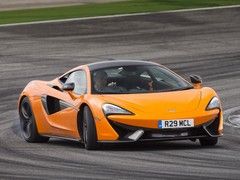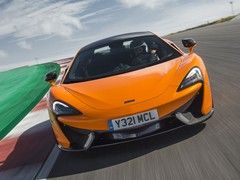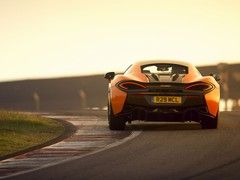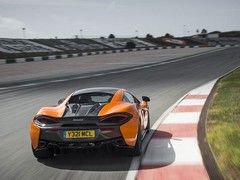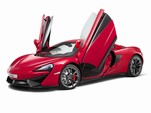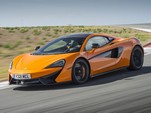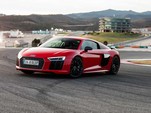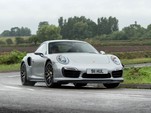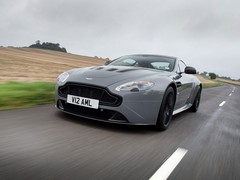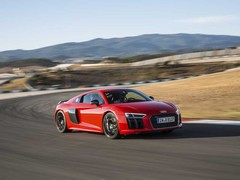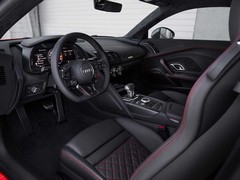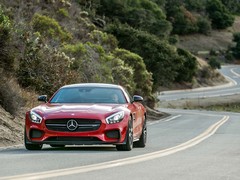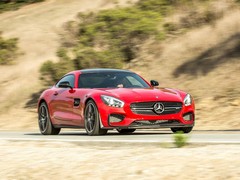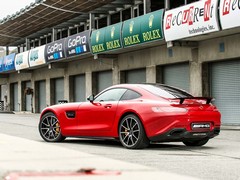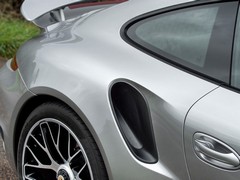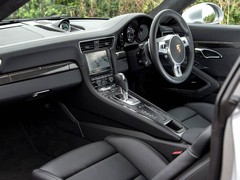McLaren 570S - the numbers
We can't tell you how it drives yet but we can compare it to its closest rivals in a game of spec sheet Top Trumps

With the 540C that launches next year starting at 'just' £126,000 and the 570S from £143,250 McLaren is landing in a fiercely competitive sector and playing to a much wider audience than it ever has before. That's obviously a huge opportunity but also brings with it increased expectation; if the Sports Series is to achieve its goal of doubling McLaren's output to around 4,000 cars a year by 2017 and win over new 'conquest' customers it's got to impress as a long-term ownership proposition as well as it does on first encounter in the showroom.
So what's it up against? With around £150K in your pocket (we'll work on the basis you've got a bit spare to lavish on some options) there are a number of ways you could go, be they luxury GTs like the Bentley Continental range, a specced up BMW M6 or AMG S-Class coupes. On the basis a McLaren customer is probably in the market for something a bit more focused there are the more traditional front-engined sports cars like the charismatic but old-school Aston Martin V12Vantage S or newer-school Mercedes-AMG GT S and impending Maserati Alfieri.
Really though the key competitors are the £142,120 Porsche 911 Turbo S and the £134,500 Audi R8 V10 Plus, with the looming threat of Ferrari's rumoured revival of its 'junior' Dino brand. Both German cars offer alternatives to the 540C in the shape of the 'regular' £120,598 520hp Turbo and £118,500, 540hp V10 but in all three cases the additional kit and performance in the 'senior' versions makes the premium pretty much a no-brainer with a little man maths applied.
Hard sell
Against both of these cars the McLaren's all-carbon tub is a genuine selling point and - Alfa Romeo 4C excepted - something unique at this price point. True, much of the bodywork is aluminium but McLaren argues this is as much about the material's suitability to create shapes impossible with carbon panels as it is cost. Pinch of salt there but the Sports Series does have a genuinely different visual identity to the Super Series cars above, which it needs if the range hierarchy is to be preserved.
McLaren needs to hammer home the functional advantages of that carbon construction too, especially when at face value the Turbo S and R8 offer 'more' in the sense they both have four-wheel drive and all manner of tech, not to mention a lot more buttons on dash and steering wheel. It may sound childish but these things matter at a superficial level.
The riposte is, of course, weight. The 570S's 1,440kg DIN kerbweight compares with 1,605kg for the aluminium Porsche and 1,555kg for the 'hybrid' part-carbon R8 V10 Plus. As McLaren boss Mike Flewitt has been quoted, the power war is inescapable but taking the initiative in a war against weight "would be really cool."
Is it though? The culture of configurable technology is deeply embedded in the rivals and it'll be interesting to see whether McLaren can successfully sell this as an advantage when people might actually prefer a ton of modes to control differentials, power splits, steering weights and the rest, weight penalty be damned.
Numbers game
Enough philosophical musing. Let's return to the playground and indulge in a little bit of Top Trumps. Engine capacity, cylinder count and power output clearly favour the R8 V10 Plus, its 5.2-litre, 610hp V10 seemingly unassailable against the 3.8-litre twin-turbos of the 570hp 570S and 560hp 911. Here McLaren has the benefit of a couple of extra cylinders and more revvy nature but the 911's monstrous 553lb ft of torque from just 2,200rpm gives it a killer blow when it comes to acceleration figures, proving horsepower is only half the story.
In comparison the 570S manages 442lb ft from 5,000rpm while the R8 suddenly seems a little breathless, needing 6,500rpm to muster its 413lb ft. The Audi and McLaren may both be bona-fide 200mph club members but - as proven in our recent drag races - the Turbo S is an absolute monster off the line and, at 3.1 seconds, a tenth faster to 62mph than either. But in 0-100mph the McLaren shows the benefit of its lack of weight, its staggering 6.3-second time putting half a second into the Porsche; for 0-124mph (200km/h in new money) it's 9.5 seconds to the Porsche's 10.3 and the Audi's 9.9. To put the 650S's performance advantage into context it'll do the same in just 8.4 seconds.
All use seven-speed dual-clutch automatic gearboxes but in putting that power to the road the Porsche again dazzles with its complexity, its four-wheel drive system boasting variable torque distribution and an active rear locking differential with full torque vectoring. It's also got that four-wheel steering, variable PASM dampers, PDCC active anti-roll bars, ceramic brakes, centre-lock wheels, variable vane turbos, active engine mounts and three-stage variable aero as standard. The Audi also has electronically controlled front-to-rear torque distribution, a mechanical limited-slip differential at the rear and gizmos like the variable ratio steering. Purists may not like the sound of it but the promise of fingertip parking in city driving and locked-out race car response on the track is one that will play well in the sales pitch. Again, ceramic brakes are standard.
Against that the McLaren's open diff and reliance on electronics rather than mechanical hardware suddenly seem - on paper - a little basic. Sure, there are three-mode dampers and Brake Steer is genuine F1 tech for the road and lighter than a mechanical locking diff. But is it enough to impress against the Germans' gizmo-led tech onslaught? Hold that thought!
MCLAREN 540C
Engine: 3,799cc twin-turbo V8
Transmission: 7-speed dual-clutch auto (SSG), rear-wheel drive
Power (hp): 540@7,500rpm
Torque (lb ft): 398@3,500-6,500rpm
0-62mph: 3.5sec
Top speed: 199mph
Weight: 1,446kg (DIN, plus driver)
MPG: 26.6 (NEDC combined)
CO2: 249g/km
Price: £126,000
MCLAREN 570S
Engine: 3,799cc twin-turbo V8
Transmission: 7-speed dual-clutch auto (SSG), rear-wheel drive
Power (hp): 570@7,500rpm
Torque (lb ft): 442@5,000-6,500rpm
0-62mph: 3.2sec
Top speed: 204mph
Weight: 1,440kg (DIN, plus driver)
MPG: 26.6 (NEDC combined)
CO2: 249g/km
Price: £143,250
AUDI R8 5.2 V10 PLUS
Engine: 5,201cc V10
Transmission: 7-speed dual clutch, four-wheel drive
Power (hp): 610@8,250rpm
Torque (lb ft): 413@6,500rpm
0-62mph: 3.2sec
Top speed: 205mph
Weight: 1,555kg (DIN, plus driver)
MPG: 23
CO2: 287g/km
Price: £134,500
PORSCHE 911 TURBO S
Engine: 3,800cc, flat-six, twin-turbocharged
Transmission: 7-speed PDK, four-wheel drive
Power (hp): 560@6,500rpm
Torque (lb ft): 553@2,200rpm
0-62mph: 3.1sec
Top speed: 198mph
Weight: 1,605kg (DIN, plus driver)
MPG: 29.0 (claimed)
CO2: 227g/km
Price: £142,120
Gassing Station | General Gassing | Top of Page | What's New | My Stuff

